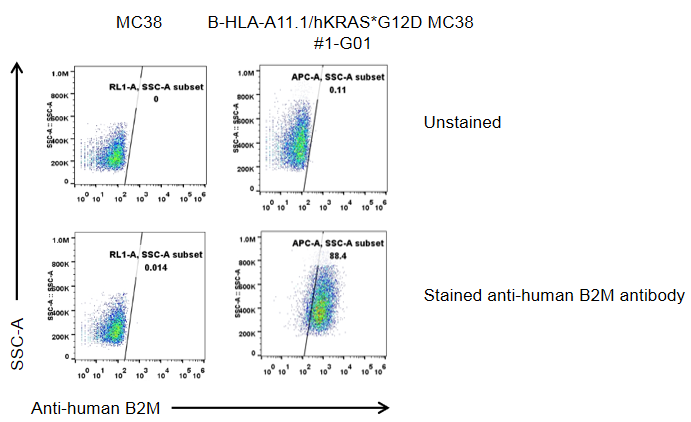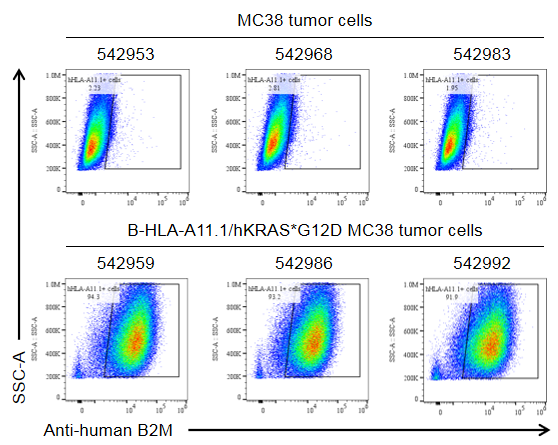B-HLA-A11.1/hKRAS*G12D MC38
|
Common name |
B-HLA-A11.1/hKRAS*G12D MC38 | Catalog number | 322402 |
| Aliases |
IMD43, AMYLD6, MHC1D4; HLAA;
NS, NS3, OES, CFC2, RALD, K-Ras, KRAS1, KRAS2
|
Disease | Colon carcinoma |
|
Organism |
Mouse |
Strain | C57BL/6 |
| Tissue types | Colon | Tissue | Colon |
- Origin: The MC38 cell line is derived from C57BL/6 murine colon adenocarcinoma cells. The cell line is a commonly used murine model for colorectal carcinoma.
- Background Information: HLA-A belongs to the HLA class I heavy chain paralogues. This class I molecule is a heterodimer consisting of a heavy chain and a light chain (beta-2 microglobulin). The heavy chain is anchored in the membrane. Class I molecules play a central role in the immune system by presenting peptides derived from the endoplasmic reticulum lumen so that they can be recognized by cytotoxic T cells. This KRAS gene, a Kirsten ras oncogene homolog from the mammalian ras gene family, encodes a protein that is a member of the small GTPase superfamily. A single amino acid substitution is responsible for an activating mutation. The transforming protein that results is implicated in various malignancies, including lung adenocarcinoma, mucinous adenoma, ductal carcinoma of the pancreas and colorectal carcinoma. Alternative splicing leads to variants encoding two isoforms that differ in the C-terminal region.
- Gene targeting strategy: The B2M gene (Exon2 to Exon3) of mouse were replaced by the sequence encompassing the human B2M CDS, HLA-A*1101 gene that included leader sequence, the KRAS*G12D peptide, the α1 and α2 domains ligated to a fragment of the murine H-2Db gene containing the α3, transmembrane and cytoplasmic domains. Human HLA-A11.1 is highly expressed on the surface of B-HLA-A11.1/hKRAS*G12D MC38.
- Application: B-HLA-A11.1/hKRAS*G12D MC38 tumor models can be used for preclinical evaluation of cancer vaccines.

Human B2M expression analysis in B-HLA-A11.1/hKRAS*G12D MC38 cells by flow cytometry. Single cell suspensions from wild-type MC38 and B-HLA-A11.1/hKRAS*G12D MC38 cells #1-G01 cultures were detected with species-specific anti-human B2M antibody (Biolegend, 395712). Human B2M was detected on the surface of B-HLA-A11.1/hKRAS*G12D MC38 cells but not wild-type MC38 cells.

Subcutaneous tumor growth of B-HLA-A11.1/hKRAS*G12D MC38. B-HLA-A11.1/hKRAS*G12D MC38 (1×106) and wild-type MC38 cells (5×105) were subcutaneously implanted into B-HLA-A11.1 mice (male, 8-week-old, n=6). Tumor volume and body weight were measured twice a week. (A) Average tumor volume. (B) Body weight. Volume was expressed in mm3 using the formula: V=0.5 × long diameter × short diameter2. Results indicate that B-HLA-A11.1/hKRAS*G12D MC38 cells were able to establish tumors in vivo and can be used for efficacy studies. Values are expressed as mean ± SEM.

Human B2M expression evaluated in B-HLA-A11.1/hKRAS*G12D MC38 tumor cells by flow cytometry. B-HLA-A11.1/hKRAS*G12D MC38 cells were subcutaneously transplanted into B-HLA-A11.1 mice (male, 8-week-old, n=6). Upon conclusion of the experiment, tumor cells were harvested and assessed with species-specific anti-human B2M antibody (Biolegend, 395706). Human B2M was highly expressed on the surface of tumor cells. Therefore, B-HLA-A11.1/hKRAS*G12D MC38 cells can be used for in vivo efficacy studies evaluating cancer vaccines.












 京公网安备:
京公网安备: